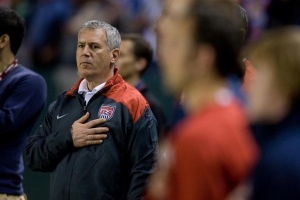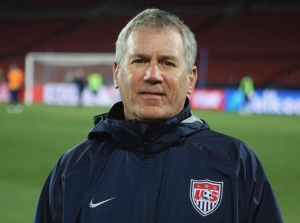 Dr. Bert Mandelbaum could perform roughly 800 knee surgeries a year.
Dr. Bert Mandelbaum could perform roughly 800 knee surgeries a year.
With an estimated 200,000 anterior cruciate ligament injuries alone per year, Mandelbaum — an acclaimed orthopedic surgeon — would have more clients than he has the capacity to handle and have a thriving practice.
But Mandelbaum yearned to make an “exponential impact.”
With more than two decades of research, Mandelbaum has earned a reputation as one of the foremost knee specialists, developing The PEP Program, which stands for Prevent Injury and Enhance Performance. He has been awarded a grant from the National Institute of Health, and he serves as the team physician for the U.S. Men’s National Soccer team, which is preparing for critical 2018 World Cup qualifiers against Costa Rica and Honduras.
“Life is a journey,” says Mandelbaum, who is also the team physician for the Los Angeles Galaxy and chief medical officer for the 2015 World Special Olympic Games and 2017 CONCACAF Gold Cup. “If you told me I’d be doing what I was doing today, I wouldn’t believe it.”
Mandelbaum recently provided SportsEngine with an exclusive A-B-C of how to decrease the chances of your child suffering a major knee injury.
(A)ware — Initially, Mandelbaum studied tapes of major knee injuries and recognized a pattern. When the femur rotates inward, it pushes the leg out of alignment and puts extra pressure on the knee. He calls that sequence “dynamic valgus,” which can often result in ACL tears, an injury that takes six to nine months to recover from.
“What happens when you watch these injuries — whether it’s a young girl or a male professional athlete — the one common thread is the femur collapses,” Mandelbaum says. “That accounts for about 90 percent of the ACL injuries.”
The problem is increasingly greater for female athletes who play basketball, lacrosse, soccer and volleyball. He likens the gait of many female athletes to that of a giraffe, which comes out of the womb wobbly, standing up straight, knees extended. One of the breakthrough findings in Mandelbaum’s research had to do with a different part of the body: The hip. When the hip muscles are weak, the added burden shifts to the knees.
(B)e proactive — Imagine a Ferrari on a racetrack, Mandelbaum says. “It’s strong and powerful,” he says, “but what if the steering wheel isn’t tight?” The foundation for knee injury prevention is “neuromuscular control,” Mandelbaum adds.

The PEP Program relies on runs, jumps and stretches that are designed to strengthen the muscles and ligaments around the knees, as well as the hip. Ancillary benefits include improved stamina and balance.
One of the initial studies was based on 61 different women’s college soccer teams that enrolled in the PEP Program. During the course of one season, those teams performed 15 to 20 minutes of warmups that integrated plyometrics, stretching and hip-specific exercises three days a week. The results were staggering: The athletes were collectively 72 percent less likely to tear an ACL.
"We want them to habituate their bodies to relearn how to land, jump and decelerate in a safe way,” Mandelbaum says.
The PEP Program is designed for athletes 12 and older. But there’s a modified version for young athletes under 12.
(C)ompliance — The NFL is the nation’s most popular sports league and, inevitably, major players suffer a season-ending knee injury during the preseason. According to the San Diego Union-Tribune, with one week of the preseason to go, 23 players have suffered a torn ACL, most notably New England Patriots receiver Julian Edelman.
The Union-Tribune article asserts that there is not an “epidemic,” pointing to more ACL tears in 2015 (26) and 2013 (31).
The NFL has considered implementing the PEP Program but there’s one major obstacle: The highly-individualized workout culture among its players.
“Many athletes have their own routine coming from different colleges or working with a personal trainer,” former Pittsburgh Steelers trainer Ariko Iso told Sports Illustrated in 2013. “They don’t really have a program the entire team does together.”
But even the programs and teams that utilize the PEP Program can fall into a trap.
“We see that when you are proactive, it makes a difference,” Mandelbaum says. “But the memory is short. We hear, ‘We’ve done all this stuff,’ or, ‘Oh, we did this last year.’ ”
Yet when ACL tears rebound, Mandelbaum says, “we’ll be back to square one.”
Meanwhile, Mandelbaum is thrilled to join the men’s national team as it aims to qualify for the 2018 World Cup in Russia. Mandelbaum initially joined the U.S. men's national team's medical team in 1991 then departed after Bruce Arena was let go in 2006. When Arena took over the Galaxy, he recruited Mandelbaum to join him. Then, last December, Arena was called upon to replace Jurgen Klinsmann, and he once again added Mandelbaum to his staff. Since then, the U.S. national team is 9-0-5.
